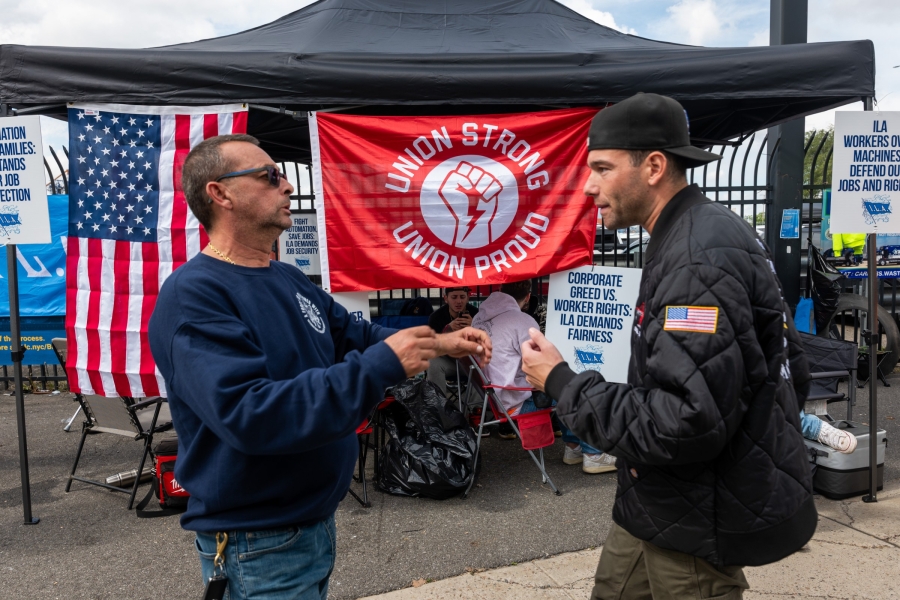
Workers at ports on the East and Gulf Coasts have agreed to go back to the docks — at least for now. Dock workers with the International Longshoremen’s Association (ILA) went on strike Tuesday following a breakdown in negotiations between the ILA and the organization of international shipping companies that employ them. Now, they are back to work as negotiations on a new contract continue.
Approximately 45,000 workers walked off the job at 12:01 am Tuesday, making it the most significant strike the union has engaged in since 1977. ILA laborers stopped work after their six-year contract with the United States Maritime Alliance (USMX) expired, shutting down 14 ports, including some of the country’s largest. That could have had a monumental impact on the US economy, with a weeks-long strike bringing higher prices and goods shortages ahead of the presidential election and holiday season.
The striking workers shut down some of the country’s biggest ports, like the Port Authority of New York and New Jersey. Overall, the affected ports handle about 50 percent of the imports and exports to the US.
The pause in the strike is an opportunity for the ILA and USMX to come back to the bargaining table and try to negotiate a new six-year contract. Workers will be covered by their old contract until next January, though the two sides have apparently made progress on a wage hike: The dockworkers have reportedly secured a 62 percent raise over the course of the new contract.
What is the International Longshoremen’s Association? Why are its members striking?
The ILA represents the approximately 45,000 workers who manage the unloading of massive shipping containers from large cargo ships. Eventually, inventory from the ships makes its way to warehouses, store shelves, and factories. The members work at ports up and down the East Coast as far north as Maine, as well as Gulf Coast ports in Louisiana and Texas.
“There’s a strike over two main issues,” Art Wheaton, director of labor studies at the Cornell University School of Industrial and Labor Relations, said. “One is money. Two is technology.”
The union has demanded a significant pay raise for dock workers over the six-year life of the contract, as well as increased contributions to their retirement plan and a say in the role of automation in their industry. Some reports indicate the union asked for as much as a 77 percent pay increase; the most recent proposal from USMX offered a 50 percent increase over the life of the contract.
“The biggest concern is, the dock workers do not want automated machines to be responsible for picking up, dropping off, and releasing the cargo automatically,” Wheaton said. “They would like to have a human operator there” to ensure the quality and safety of their operations — and job security.
Negotiations between USMX and ILA for a new contract stopped in June, reportedly over the use of automation at a port in Mobile, Alabama. USMX filed a complaint with the National Labor Review Board last week claiming that ILA refused to continue with contract negotiations. USMX did not respond to Vox’s request for comment.
Shipping companies that compose USMX — all of which are based abroad — have made billions as global trade and shipping has boomed, the union argues, while worker wages have stagnated in the face of inflation.
Dock workers on the West Coast make about $55 per hour compared with the East and Gulf Coast average of $39 per hour for experienced workers. West Coast dockworkers received an impressive wage increase in their most recent contract; they belong to a different union, the International Longshoremen and Warehouse Union (ILWU), which has long been much more radical than the ILA in terms of its politics, demands, and tactics, according to Gabe Winant, a labor historian at the University of Chicago.
But the ILWU workers’ big wage wins proved that it was possible to demand more — and get it.
Now, the ILA hopes to achieve a similar victory.
Which goods will be impacted?
More than 50 percent of all goods imported into the US using container ships come in through the East and Gulf Coast ports, and nearly 70 percent of containerized exports leave through them. However, since the potential for a strike had been well-known for months, companies had plenty of time to prepare. The most immediate casualty of the strikes would have been perishables.
“We have all these perishable goods coming imported [to] the East Coast,” like blueberries, bananas, and fish from South America, Chris Tang, a professor of supply chain management at UCLA, told Vox. “We also have apparel, toys, electronics, we import through the East Coast.”
The automotive industry also depends on East Coast ports, as many cars and car parts are imported from Europe. “There’s still some inventories available in the car manufacturing, and as well as the car dealers, so in the short term, it is not a major impact,” Tang said. Under a prolonged strike, that inventory will run out, and car repairs could become more challenging as parts shipments are delayed.
In addition to the strike, there are other factors affecting global shipping at the moment, including Houthi attacks in the Red Sea that have disrupted shipping since November of last year, as has extreme weather. The Panama Canal has also been impacted independent of the strikes; the waterway is suffering from a drought, which has created a shipping backlog there.
“As anyone who tried to buy toilet paper during the pandemic can tell you, we have a delicate supply chain, and when you start messing with the cargo ships, the rail, and the semi trucks, you’re toast,” Wheaton said. “You just aren’t going to get anything moved. Add to that that you just had a huge chunk of the East Coast get buried in water from the hurricane that just went through.”
How might the dockworker’s strike end?
The progress on negotiations is a positive sign. The two sides agreed on January 15, 2025, deadline for finalizing a new contract, which gives them a cushion to negotiate on outstanding issues, namely the role of automation at the ports and an increase in pension contributions.
Given the enormity of the potential fallout from the strike, there was some question of whether President Joe Biden would order dockworkers back to the ports for 80 days as USMX and the ILA continue contract negotiations through powers granted by the Taft-Hartley Act — something Biden said he did not want to do.
The administration faced “pressure from the consumers, from the retailers, from the manufacturers, and also the shipping companies” to take action and reopen the ports, Tang said. Some business groups had already called on Biden to send ILA members back to work.
But Biden has also been largely supportive of union action, save the 2022 railway workers strike, and union support has been important to Vice President Kamala Harris’s campaign.
“The official policy of the government for more than 100 years, that the best solution is a negotiated solution,” Wheaton said. “The union won’t get everything they want, management won’t get everything they want, but you sit at the bargaining table to see what both sides can live with.”
Update, October 4, 10:40 am ET: This story was originally published on October 1 and has been updated to reflect the dock workers’ return to work as a contract is negotiated.
Source: vox.com






